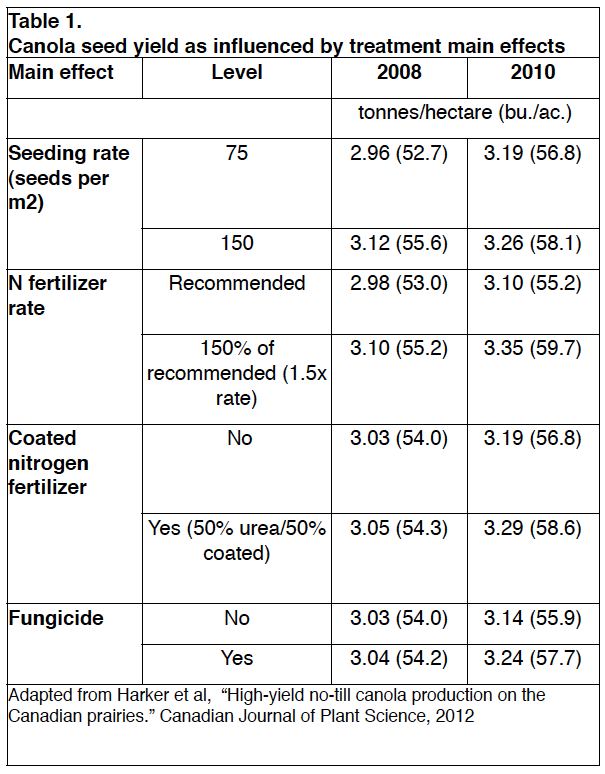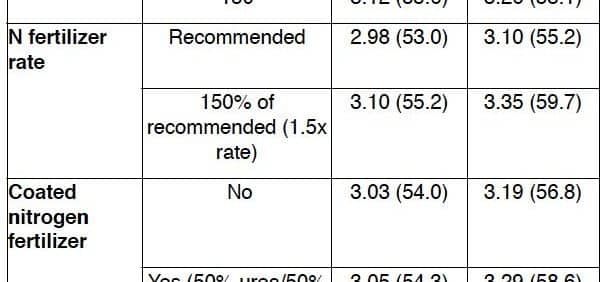If you’ve budgeted for hybrid seed and optimal herbicide, insecticide and fertilizer applications, and you’d like to spend a little extra to push yields, consider a higher nitrogen rate. This is the key message from a recent study by Neil Harker and 17 other scientists from across the Prairies. The work was just published in the Canadian Journal of Plant Science under the title, “High-yield no-till canola production on the Canadian prairies.”
The study compared canola yields for two seeding rates (75 vs. 150 seeds m2) and two nitrogen rates (100% vs. 150% of soil test recommendation) in plots at 8 sites across the Prairies in 2008 and 2010. At each site, wheat was seeded in 2009 between the two canola treatments. Herbicides, insecticides and fertilizers other than nitrogen were applied as required for optimal canola production. (Yield results in the study were reported in tonnes per hectare. See the table at the bottomfor conversion to bushels per acre.)
—Nitrogen rate results: In 2008, higher than recommended nitrogen rates (150%) increased canola yields by 0.12 tonnes per hectare (t/ha), on average, compared to the recommended (100%) rate. The actual yields were 2.98 t/ha for 100% and 3.10 t/ha for 150%. In 2010, high rates increased canola yields by 0.25 t/ha compared to the recommended rate. The actual yields were 3.10 t/ha for 100% and 3.35 t/ha for 150%. This supports previous studies indicating that hybrid canola yields are often optimized at higher than ‘‘normal’’ rates of nitrogen. These results were statistically significant both years.
—Seeding rate results: In 2008, high (150 seeds per meter square) increased canola yields by 0.16 t/ha compared to low (75 seeds per meter square) seeding rates. Actual yields in 2008 were 2.96 t/ha for the low rate versus 3.12 for the high. In 2010, the high seeding rate yielded 0.07 t/ha more than the low. Actual yields were 3.19 t/ha for the low rate versus 3.26 for the high. These results were statistically significant both years. Assuming 50% seed survival in the field, the low rate does not achieve the minimum stand required for canola to reach its yield potential, so this is consistent with previous research.
—Nitrogen source: The study also compared 100% urea versus a blend of 50% urea with 50% polymer-coated nitrogen. In 2008, the coated nitrogen did not provide a yield benefit. In 2010, the nitrogen source with 50% polymer coated increased average yield to 3.29 t/ha, up from 3.19 for treatments with 100% urea. All fertilizer was side-banded during planting, 2 cm beside and 3-4 cm below the seed row.
—Fungicide: The study compared treatments with and without fungicide applied at the timing for sclerotinia management. In 2008, fungicide provided no yield benefit. In 2010, fungicide treated plots had an average yield of 3.24 t/ha compared to 3.14 for plots without.
—Rotation: The study included a few extra trials with canola seeded in 2009 instead of wheat (canola-canola-canola versus canola-wheat-canola.) In 2010, the high-input canola following wheat yielded substantially more (3.50 t/ha) than the same high-input treatment on canola stubble (3.22 t/ha).
Individual sites were influenced by site conditions such as soil organic matter, days to maturity, and temperature, but these site and environmental predictors did not alter treatment rankings. Using higher than the soil test recommended rate of nitrogen or planting 150 versus 75 seeds m2 increased canola yields consistently across western Canada. This study did not analyze the economic return of any treatments.

